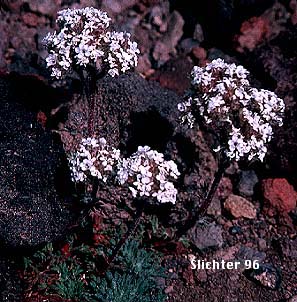

Many-flowered gilia is also known as ball-head gilia. It is an attractive perennial arising from a taproot. The several to numerous stems range from spreading and prostrate to erect and range from 5-50 cm high. The stems may be simple to branched. The herbage of stems and leaves ranges from glabrous to covered with white, woolly hairs. Depending on the variety, the leaves are either all basal or largely on the stems. The leaves of the Pacific Northwest varieties are usually trifid to palmatifid.
The flowers are numrous in one to several dense, terminal cymes. Individual flowers are sessile with white flowers. The 5 lobes of the calyx are 3-5 mm long, about equalling the corolla tube. The oblong corolla lobes are spreading, usually 1.5-3 mm long, and long persistent.
Variety congesta: Leaves pinnately lobed or trifid. Leaves 1-2.5 cm long. Plants of lower, drier, desert areas of eastern Oregon and places further east.
Variety montana: Most of the leaves are trifid to pinnatifid and found crowded on short, sterile shoots, forming a basal mat. Plants are subalpine to alpine, often less than 10 cm high. Found in the southern Oregon Cascade Mts., Siskiyou Mts. and in the Blue Mts..
Variety palmifrons: Most leaves are palmatifid and found scattered along the flower stems, although occasionally mostly near the base. Plants of lower elevations, although occasionally alpine. Plants are often from 20-30 cm high.
Subspecies viridis: Montane plants of the Wallowa Mountains of northeastern Oregon.
Ball-head gilia may be found in dry, open places in the plains and foothills and at high elevations in the mountains.
As a species, ball-head gilia may be found from the Siskiyou Mts., southern Oregon Cascade and central and eastern Oregon and then east to western North Dakota, western Nebraska, Wyoming and Colorado. It is found south to California.
Variety montana is found from higher elevations in the Sierra Nevada and southern Oregon Cascades south to the White Mts. of California and Glass Mt. in Mono County, California. Eastward it begins to intergrade into variety palmifrons.
Variety palmifrons is found at lower elevations from the eastern foothills of thesouthern Cascade Mts. and Sierra Nevada Mts. east across Harney and Jackson Counties of Oregon, across southwestern Idaho, and south through much of Nevada and western Utah. It is also found along the Salmon River in Custer and Lemhi Counties in Idaho.
